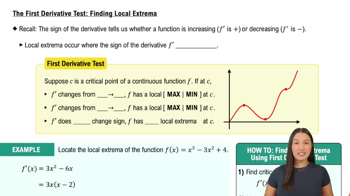Use the graphs of ƒ' and ƒ" to complete the following steps. <IMAGE>
c. Determine where f has local maxima and minima.
 Verified step by step guidance
Verified step by step guidance Verified video answer for a similar problem:
Verified video answer for a similar problem:



 5:58m
5:58mMaster Finding Extrema Graphically with a bite sized video explanation from Patrick
Start learning